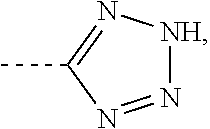Cyclopropylamine compound as lsd1 inhibitor and use thereof
- Summary
- Abstract
- Description
- Claims
- Application Information
AI Technical Summary
Benefits of technology
Problems solved by technology
Method used
Image
Examples
embodiment 1
[0082]
[0083]Synthetic Route:
Step 1
[0084]Sodium hydroxide (279 g, 6.99 mol) was dissolved in water (3 L), then the reaction mixture was cooled to 10° C. with an ice-water bath, compound 1-1 (997 g, 3.49 mol) was added to the reaction mixture in batches, and the reaction mixture was stirred at 10° C. for 2 hours. Ethyl acetate (2 L×1) was added to the reaction mixture for extraction, the mixture was extracted with ethyl acetate (1.6 L×1). The organic phases were combined, washed with water (1.5 L×1), and then washed with saturated brine (1.5 L×1). The organic phase was dried over anhydrous sodium sulfate, filtered, and concentrated under reduced pressure to remove the solvent to obtain the compound 1-2. 1H NMR (400 MHz, CDCl3) δ 7.18-7.14 (m, 2H), 7.08-7.04 (m, 1H), 6.95-6.92 (m, 2H), 2.48-2.44 (m, 1H), 1.80-1.76 (m, 1H), 0.98-0.87 (m, 2H).
Step 2
[0085]Compound 1-3 (1.00 g, 6.62 mmol) and compound 1-4 (1.50 g, 9.26 mmol) were dissolved in 1, 2-dichloroethane (10 mL). The reaction mixtu...
embodiment 2
[0091]
[0092]Synthetic Route:
Step 1
[0093]Compound 2-1 (194 mg, 0.856 mmol) and compound 1-2 (114 mg, 0.856 mmol) were dissolved in anhydrous dichloromethane (1 mL), glacial acetic acid (154 mg, 2.57 mmol) was added to the reaction mixture. The reaction mixture was stirred at 26° C. for 2 hours, sodium triacetoxyborohydride (544 mg, 2.57 mmol) was added thereto, and the reaction mixture was stirred at 26° C. for 10 hours. Saturated sodium bicarbonate (30 mL) solution was added to the reaction mixture, extracted with dichloromethane (30 mL×3), the organic phases were combined and washed with saturated brine (30 mL×1), then dried over anhydrous sodium sulfate, filtered, and the mother liquor was concentrated, the crude product was purified by thin layer chromatography (2:1 petroleum ether / ethyl acetate, Rf=0.26) to obtain compound 2-2. MS-ESI calculated value [M+H]+ 345, measured value 345.
Step 2
[0094]Compound 2-2 (154 mg, 0.447 mmol) was dissolved in anhydrous dichloromethane (5 mL), t...
embodiment 3
[0098]
[0099]Synthetic Route:
Step 1
[0100]Compound 3-1 (89.1 mg, 0.543 mmol) and compound 1-9 (100 mg, 0.271 mmol) were dissolved in anhydrous dichloromethane (2 mL), and glacial acetic acid (48.9 mg, 0.814 mmol) was added thereto. The reaction mixture was stirred at 0-30° C. for 12 hours, sodium triacetoxyborohydride (173 mg, 0.814 mmol) was added thereto, and the reaction mixture was stirred at 30° C. for 1 hour. Saturated sodium bicarbonate solution (20 mL) was added to the reaction mixture, the mixture was extracted with dichloromethane (10 mL×3), and the combined organic phase was washed with water (10 mL×1) and saturated brine (10 mL×1) in sequence, the mixture was then dried over anhydrous sodium sulfate, filtered, the filtrate was concentrated, and the crude product was purified by thin layer chromatography (3:1 petroleum ether / ethyl acetate, Rf=0.86) to obtain compound 3-2. MS-ESI calculated value [M+H]+ 517, measured value 517.
Step 2
[0101]Compound 3-2 (30.0 mg, 0.580 mmol) w...
PUM
 Login to View More
Login to View More Abstract
Description
Claims
Application Information
 Login to View More
Login to View More - R&D
- Intellectual Property
- Life Sciences
- Materials
- Tech Scout
- Unparalleled Data Quality
- Higher Quality Content
- 60% Fewer Hallucinations
Browse by: Latest US Patents, China's latest patents, Technical Efficacy Thesaurus, Application Domain, Technology Topic, Popular Technical Reports.
© 2025 PatSnap. All rights reserved.Legal|Privacy policy|Modern Slavery Act Transparency Statement|Sitemap|About US| Contact US: help@patsnap.com



